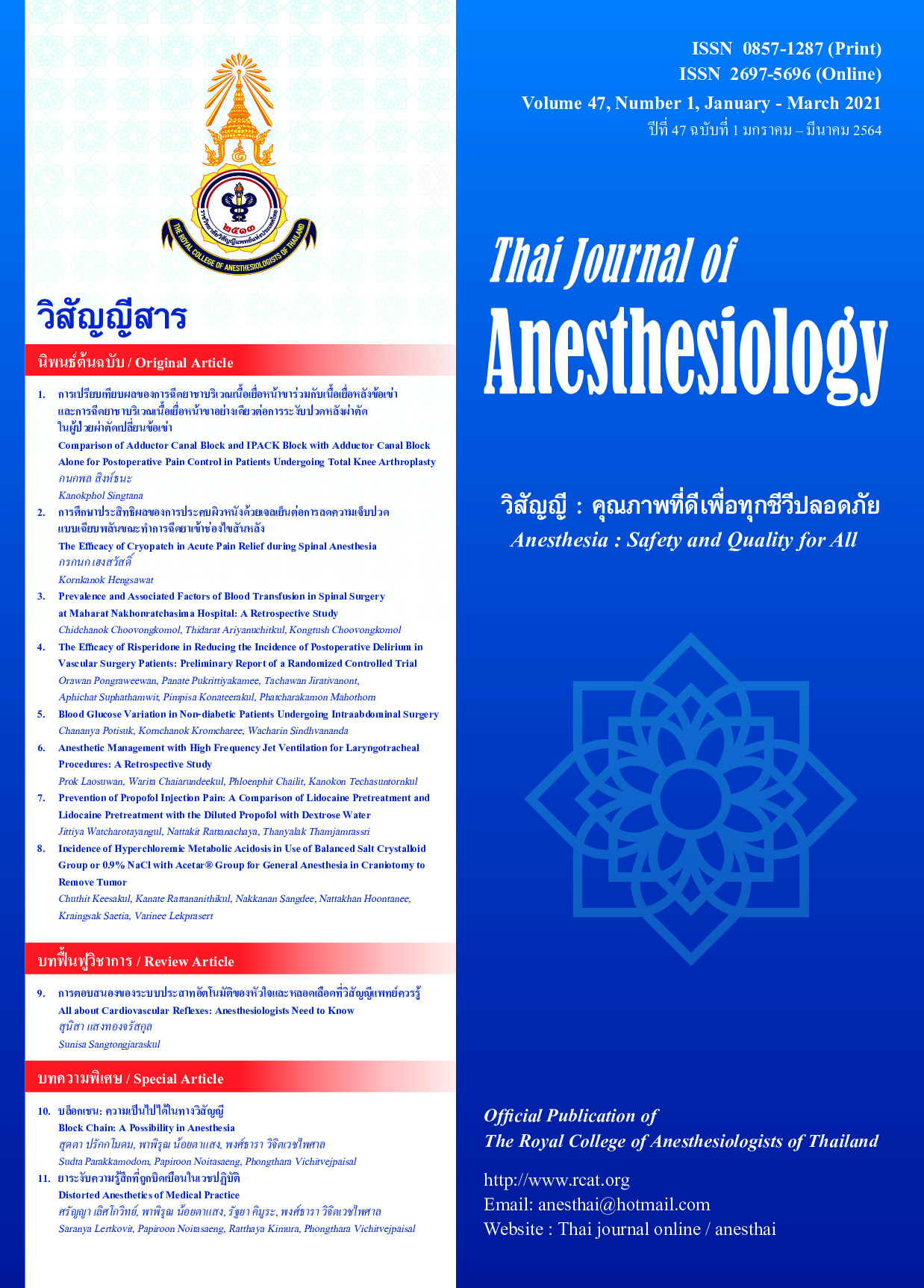Anesthetic Management with High Frequency Jet Ventilation for Laryngotracheal Procedures: A Retrospective Study
Main Article Content
Abstract
Background: Good surgical exposure and unhindered
laryngeal area are an ideal component in tracheolaryngeal
surgery. High frequency jet ventilation (HFJV) has been
developed over decades for these procedures. The
safety of this technique was proved. The aim of this study
was to report the success rate and safety of anesthesia
with HFJV technique in a tertiary university hospital in
Thailand.
Methods: We reviewed both elective and emergency
cases of laryngotracheal procedures which were
under general anesthesia with HFJV technique at the
Ear-Nose-Throat operating theater of King Chulalongkorn
Memorial Hospital between August 2013 to March 2016.
The characteristics, details of anesthesia technique, and
surgery immediate outcomes were examined.
Results: A total of 45 cases in 43 patients were included
to the case series. There were 31 male and 14 female patients. The mean age was 45 years old (range 11 to 84
years old). Common symptoms were dyspnea (40%) and
hoarseness (32.6%). The common diagnosis was
subglottic stenosis which needed reduction of stenosis
with or without laser assistance. All of the cases received
total intravenous anesthesia (TIVA) during HFJV. Mean
operation time was 38.7 minutes (range 15 to 115
minutes). Complications were hypoxia (4.4%), failed HFJV
(2.2%) due to outflow obstruction and airway fire (2.2%).
No death or barotrauma was reported.
Conclusion: Anesthesia with HFJV in most of patients
who underwent laryngotracheal procedures was safe and
successful with a small amount of minor adverse
outcomes.
Article Details
References
surgery. Laryngoscope 1973;83:1228-33.
2. Brummitt WM, Fearon B, Brama I. Anesthesia for laryngeal
laser surgery in the infant and child. Ann Otol Rhinol Laryngol
1981;90:475-7.
3. Edelist G, Alberti PW. Anesthesia for CO2 laser surgery of
the larynx. J Otolaryngol 1982;11:107-10.
4. Cook TM, Alexander R. Major complications during
anaesthesia for elective laryngeal surgery in the UK:
a national survey of the use of high-pressure source
ventilation. Br J Anaesth 2008;101:266-72.
5. Sanders RD. Two ventilating attachments for bronchoscopes.
Del Med J 1967;39:170.
6. Klain M, Smith RB. High-frequency percutaneous
trans-tracheal jet ventilation. Crit Care Med 1977;5:280-7.
7. Babinski M, Smith RB, Klain M. High-frequency jet ventilation
for laryngoscopy. Anesthesiology 1980;52:178-80.
8. Eriksson I, Sjöstrand U. Clinical evaluation of high-frequency
positive-pressure ventilation (HFPPV) in laryngoscoy under
general anaesthesia. Acta Anaesthesiol Scand 1977;64:
(S)101-10.
9. Eriksson I, Nilsson LG, Nordström S, Sjöstrand U.
High-frequency positive-pressure ventilation (hfppv) during
transthoracic resection of tracheal stenosis and during
peroperative bronchoscopic examination. Acta Anaesthesiol
Scand 1975;19:113-9.
10. Bourgain JL, Desruennes E, Fischler M, Ravussin P.
Transtracheal high frequency jet ventilation for endoscopic
airway surgery: a multicentre study. Br J Anaesth 2001;
87:870-5.
11. Evans E, Biro P, Bedforth N. Jet ventilation. BJA Education
2007;7:2-5.
12. Ross-Anderson DJ, Ferguson C, Patel A. Transtracheal jet
ventilation in 50 patients with severe airway compromise and
stridor. Br J Anaesth 2011;106:140-4.
13. Jaquet Y, Monnier P, Melle GV, Ravussin P, Spahn DR,
Chollet-Rivier M. Complications of different ventilation
strategies in endoscopic laryngeal surgery - A 10-year
review. Anesthesiology 2006;104:52-9.
14. Helmstaedter V, Tellkamp R, Majdani O, Warnecke A,
Lenarz T, Durisin M. High-frequency jet ventilation for
endolaryngotracheal surgery–chart review and procedure
analysis from the surgeon’s and the anaesthesiologist’s point
of view. Clin Otolaryngol 2015;40:341-8.
15. Hautmann H, Gamarra F, Henke M, Diehm S, Huber RM.
High frequency jet ventilation in interventional fiberoptic
bronchoscopy. Anesth Analg 2000;90:1436-40.
16. Grasl MC, Donner A, Schragl E, Aloy A. Tubeless
laryngotracheal surgery in infants and children via jet
ventilation laryngoscope. Laryngoscope 1997;107:277-81.
17. Depierraz B, Ravussin P, Brossard E, Monnier P. Percutaneous
transtracheal jet ventilation for paediatric endoscopic laser
treatment of laryngeal and subglottic lesions. Can J Anaesth
1994;41:1200-7.
18. Hu S, Dong HL, Sun YY, et al. Anesthesia with sevoflurane
and remifentanil under spontaneous respiration assisted with
high-frequency jet ventilation for tracheobronchial foreign
body removal in 586 children. Paediatr Anaesth 2012;
22:1100-4.
19. Satoh M, Hirabayashi Y, Seo N. Spontaneous breathing
combined with high frequency ventilation during bronchoscopic
resection of a large tracheal tumour. Br J Anaesth 2002;
89:641-3.
20. Buczkowski PW, Fombon FN, Lin ES, Russell WC, Thompson
JP. Air entrainment during high-frequency jet ventilation in a
model of upper tracheal stenosis. Br J Anaesth 2007;
99:891-7.
21. Simon M, Gottschall R, Gugel M, Fritz H, Mohr S, Klein U.
Comparison of transcutaneous and end tidal CO2-monitoring
for rigid bronchoscopy during high-frequency jet ventilation.
Acta Anaesthesiol Scand 2003;47:861-7.
22. Frietsch T, Krafft P, Becker HD, Buelzebruck H, Wiedemann
K. Intermittent capnography during high-frequency jet
ventilation for prolonged rigid bronchoscopy. Acta
Anaesthesiol Scand 2000;44:391-7.
23. Desruennes E, Bourgain JL, Mamelle G, Luboinski B. Air-way
obstruction and high frequency jet ventilation during
laryngoscopy. Ann Otol Rhinol Laryngol 1991;100:922-6.
24. Shikowitz MJ, Abramson AL, Liberatore L. Endolaryngeal jet
ventilation: a 10-year review. Laryngoscope 1991;101:455-61.
25. Altun D, Camci E, Orhan-Sungur M, Sivrikoz N, Basaran B,
Özkan-Sevhan T. High frequency jet ventilation during
endolaryngeal surgery: Risk factors for complications. Auris
Nasus Larynx 2018;45:1047-52.
26. Galmén K, Harbut P, Freedman J, Jakobsson JG. The use of
high-frequency ventilation during general anaesthesia: an
update. F1000Research. 2017;6:756.
27. Santos P, Ayuso A, Luis M, Martinez G, Sala X. Airway ignition
during CO2 laser laryngeal surgery and high frequency jet
ventilation. Eur J Anaesthesiol 2000;17:204-7.
28. Wegrzynowicz ES, Jensen NF, Pearson KS, Wachtel RE,
Scamman FL. Airway fire during jet ventilation for laser
excision of vocal cord papillomata. Anesthesiology 1992;
76:468-9.
29. Galmén K, Harbut P, Freedman J, Jakobsson JG. High
frequency jet ventilation for motion management during
ablation procedures, a narrative review. Acta Anaesthesiol
Scand 2017;61:1066-74.
30. Lemay F, Cooper J, Thompson S, Scott J. Combination of
transnasal humidified rapid-insufflation ventilatory exchange
with high frequency jet ventilation for shared airway surgery.
Can J Anaesth 2020; doi:10.1007/s12630-020-01635-2.


